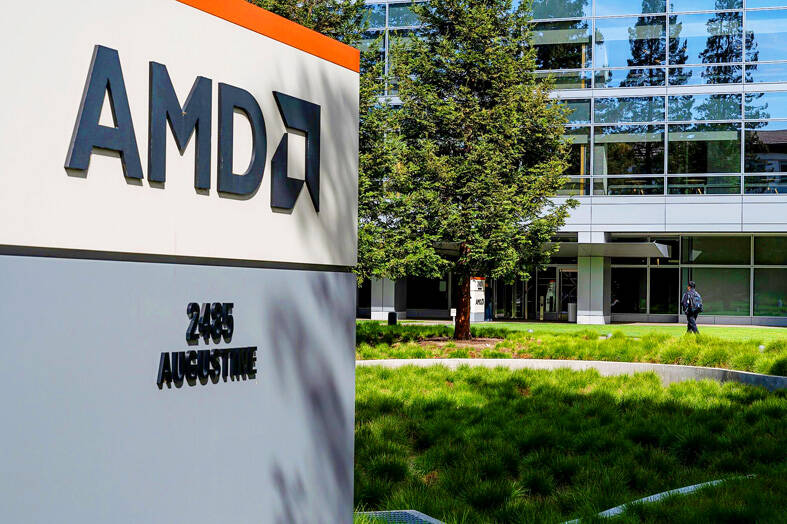Advanced Micro Devices Inc (AMD) on Tuesday gave an upbeat revenue forecast, underscoring that its new artificial intelligence (AI) processors are boosting growth.
Revenue will be roughly US$6.7 billion in the third quarter, the company said. Analysts estimated US$6.62 billion on average. Second-quarter results also topped projections, and the company raised its forecast for so-called AI accelerators — chips used to develop AI models.
The outlook suggests that AMD is making headway in its pursuit of Nvidia Corp, which dominates the accelerator market.

Photo: David Paul Morris, Bloomberg
Chief executive officer Lisa Su (蘇姿丰) said that AMD expects to generate more than US$4.5 billion in sales from its MI300 products this year. That’s up from an earlier target of US$4 billion, though analysts’ estimates have ranged closer to US$5 billion. The growth reflects an effort to ramp up production, but supplies continue to be tight, she said.
Su downplayed concerns that the race to add AI infrastructure is slowing down, saying that customers are still eager to chase the opportunity.
“The overall view on AI investment is: We have to invest — the potential of AI is so large,” she said on a conference call with analysts. “The investment cycle will continue to be strong.”
MI300 revenue topped US$1 billion in the second quarter, and the company committed to rolling out new AI processors once a year — a key milestone.
“We continued accelerating our AI traction,” Su said. Cloud computing and enterprise customers are embracing AMD’s Instinct MI300X products, she said. And demand is picking up for its traditional personal-computing and server businesses.
AMD’s second-quarter revenue rose 8.9 percent to US$5.84 billion, beating an estimate of US$5.72 billion. Earnings increased to US$0.69 a share, compared with a projection of US$0.68.
Though demand for AI accelerators has been strong, the appetite for some other AMD products has slowed. Embedded chips and semiconductors for gaming consoles have struggled recently.
Like Intel Corp, AMD still gets most of its revenue from PC and server microprocessors. Santa Clara, California-based AMD also competes with Nvidia in the market for graphics processors that improve the images in video games.
Separately, Intel plans to eliminate thousands of jobs to reduce costs and fund an ambitious effort to rebound from an earnings slump and market share losses.
The workforce reduction may be announced as early as this week, according to people familiar with the company’s plans. Intel, which is scheduled to report second-quarter earnings today, has about 110,000 employees, excluding workers at units that are being spun out.
Intel’s once-dominant position eroded under chief executive officer Pat Gelsinger’s predecessors as rivals, such as AMD, have caught up and taken market share.
Other chipmakers led by Nvidia have sprinted ahead in the development of lucrative semiconductors tailored for demanding AI-related tasks. Intel is also coming to grips with uneven demand for chips that run laptops and desktop computers, its main business.
The company reduced its workforce about 5 percent last year to 124,800 after announcing job cuts beginning in October 2022. It also has slowed spending in other areas. The company expected those cost reductions would save as much as US$10 billion by next year.

Application-specific integrated circuit designer Faraday Technology Corp (智原) yesterday said that although revenue this quarter would decline 30 percent from last quarter, it retained its full-year forecast of revenue growth of 100 percent. The company attributed the quarterly drop to a slowdown in customers’ production of chips using Faraday’s advanced packaging technology. The company is still confident about its revenue growth this year, given its strong “design-win” — or the projects it won to help customers design their chips, Faraday president Steve Wang (王國雍) told an online earnings conference. “The design-win this year is better than we expected. We believe we will win

Intel Corp chief executive officer Lip-Bu Tan (陳立武) is expected to meet with Taiwanese suppliers next month in conjunction with the opening of the Computex Taipei trade show, supply chain sources said on Monday. The visit, the first for Tan to Taiwan since assuming his new post last month, would be aimed at enhancing Intel’s ties with suppliers in Taiwan as he attempts to help turn around the struggling US chipmaker, the sources said. Tan is to hold a banquet to celebrate Intel’s 40-year presence in Taiwan before Computex opens on May 20 and invite dozens of Taiwanese suppliers to exchange views

Chizuko Kimura has become the first female sushi chef in the world to win a Michelin star, fulfilling a promise she made to her dying husband to continue his legacy. The 54-year-old Japanese chef regained the Michelin star her late husband, Shunei Kimura, won three years ago for their Sushi Shunei restaurant in Paris. For Shunei Kimura, the star was a dream come true. However, the joy was short-lived. He died from cancer just three months later in June 2022. He was 65. The following year, the restaurant in the heart of Montmartre lost its star rating. Chizuko Kimura insisted that the new star is still down

While China’s leaders use their economic and political might to fight US President Donald Trump’s trade war “to the end,” its army of social media soldiers are embarking on a more humorous campaign online. Trump’s tariff blitz has seen Washington and Beijing impose eye-watering duties on imports from the other, fanning a standoff between the economic superpowers that has sparked global recession fears and sent markets into a tailspin. Trump says his policy is a response to years of being “ripped off” by other countries and aims to bring manufacturing to the US, forcing companies to employ US workers. However, China’s online warriors